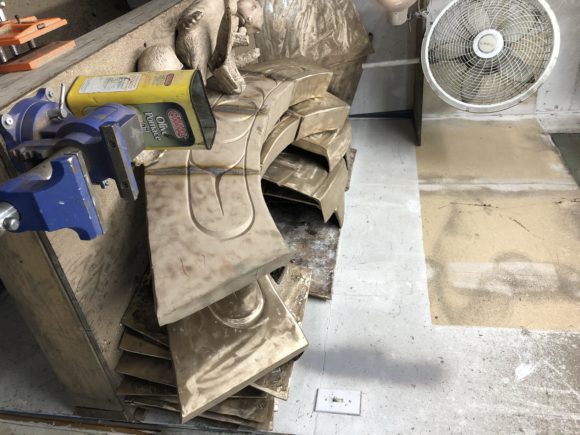02 Jun 2022
Creating a Bronze Disc Base for Reconciliation Pole
Through a unique collaboration between Musqueam artist Richard Campbell and 7idansuu James Hart (Haida), work is underway on the production of a large-scale cast bronze disc that will be installed at the base of Hart’s Reconciliation Pole (2015-17), with funds generously donated by the Audain Foundation.
Reconciliation Pole: Honouring a Time Before, During and After Canada’s Indian Residential Schools was erected at the south end of UBC in 2017 to symbolize the tragedy brought by the residential school system, to memorialize the students who died, to tell the stories of the time before and to present hopes for a more respectful future. It was part of Hart’s original vision for the pole to include a bronze disc at its base to acknowledge the physical contact point where the artwork meets Musqueam land. As part of this vision, Hart invited Musqueam artist Richard Campbell to develop and carve the design that is now in the process of being cast in bronze to be fitted in sections around the pole.
Having grown up in a family of carvers, Campbell has honed his craft for over 40 years. The artist has completed pieces within the Vancouver area and in Quebec while also working as an archaeologist for the Musqueam Band for 23 years. In preparation for the carving, Hart worked with artist Max Chickite (Lekwiltok, Kwakwaka’wakw) to fashion a to-scale disc in high-density foam for Campbell to carve his design into.
The Department of Art History, Visual Art and Theory (AHVA) offered Campbell a workspace in the third floor studios in the Audain Art Centre that would accommodate the foam disc’s generous scale, while at the same time providing a valuable open-studio experience for students. The collaboration between artists unfolded, with visual arts students observing Campbell at work, asking questions and even taking part in the carving process.
AHVA staff were able to connect Hart and Campbell throughout the design process through live-remote communication technologies – their collaboration thereby becoming accessible to the students, design team, engineers, fabricators and other project contributors. In the final stages, Chickite re-joined the team onsite to finalize the carved design with Campbell and prepare the carved panels for transport to Burton Bronze Foundry on Salt Spring Island. In March 2022, the Belkin’s Curator of Outdoor Art, Barbara Cole, visited the foundry with James Hart, who was particularly pleased with the organic quality of the casting. Work will continue on engineering the attachment to the concrete foundation and a plan for its installation and patination on campus. It is anticipated that Bronze Disc will be completed in the summer of 2022.
We are grateful to the Audain Foundation for their support of the creation and production of the Bronze Disc.
View the video documenting the Bronze Disc project.



Image (above): Richard Campbell, Max Chickite and AHVA students Kiana Shahnia and Michelle Chang at the Audain Art Centre. Photo: Jeremy Jaud
Related
-
Event
1 Apr 2017, 1 pm
Reconciliation Pole Raising: Honouring a Time Before, During and After Canada’s Indian Residential Schools
Reconciliation Pole is situated on the traditional, ancestral, and unceded territory of the Musqueam people. This 800-year-old red cedar tree was shipped from the island of Haida Gwaii and is being carved under the direction of master carver and hereditary chief, 7idansuu (Edenshaw), James Hart with the helping hands of Gwaliga Hart, John Brent Bennett, Brandon Brown, Jaalen Edenshaw, Derek White, Leon Ridley and late son Carl Hart, all of the Haida Nation of Haida Gwaii.
[more] -
News
11 Nov 2021
James Hart 7idansuu Awarded the 2021 Audain Prize
 [more]
[more]